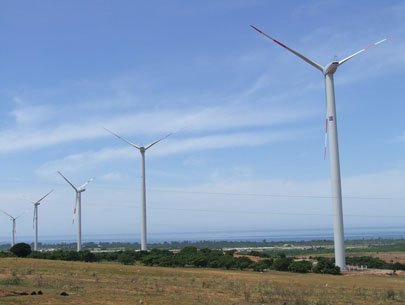Gleaming white and spanking new, the five Fuhrlaender FL1500 wind turbines rise from a sandy hillside in the southern coastal province of Binh Thuan. Eighty-five metres high with a generating capacity of 1.5 megawatts each, they are the tallest, most sophisticated wind turbines in Vietnam.
Unfortunately, they don't have much competition.
Vietnam is desperate for electricity to feed its economy, which bucked the worldwide recession and grew more than 5 per cent this year. Electricity demand is growing even faster, by more than 10 per cent each year through 2030, according to forecasts.
Much of that electricity could come from wind. A recent World Bank study found Vietnam could produce more than 500 gigawatts of electricity from land-based and off-shore wind farms, 10 times the country's expected national demand in 2020.
But for now, the wind farm at Binh Thuan, a joint venture between the German wind power company Fuhrlaender AG and the Vietnamese renewable energy company REVN, is one of two operating in Vietnam. The other, the 50-megawatt Phuong Mai 3 wind farm in the central province of Binh Dinh, opened in 2008.

Five wind turbines of REVN in Binh Thuan Province.
More wind farms are scheduled to come online in 2010 in the Central Highlands city of Dalat and on the southern islands of Con Dao. But for the most part, the promise of wind energy in Vietnam has yet to materialize.
Vietnam has embraced the idea that carbon emissions and global warming are a serious threat. The country is among the developing nations most likely to be harmed by climate change, according to the World Bank, largely because of its low-lying Mekong and Red River deltas, which would be largely submerged if predictions of sea-level rises prove correct.
And while Vietnam itself, with its 85-billion-dollar economy, is hardly a major contributor to global emissions, Vietnamese largely see themselves as part of any global effort to slow emissions.
'We have to do our part if we expect others to do theirs,' said National Assembly deputy Nguyen Minh Thuyet.
But it's not just wind power; other renewable energy technologies are lagging in Vietnam, too. Conservation efforts have scarcely begun, and with energy demand growing so quickly, the medium-term forecast is more pollution and more carbon dioxide emissions.
At a green business conference in Hanoi in September, panelists explored the reasons for the delay in launching renewable energy projects.
'The problem is simple,' said Oliver Massmann, and energy sector expert. 'Who will pay?'
Massman and other participants explained that Vietnam's government keeps electricity prices low to benefit poor consumers and export businesses. Consumers pay an average of 7 cents per kilowatt hour for electricity while electricity from wind turbines cannot be sold profitably for less than 10 cents per kilowatt hour.
The government lacks the funds to subsidize wind or other renewable energy sources on a large scale. Instead, to meet its urgent electricity needs over the next five years, Vietnam is turning to an old, reliable solution: coal. Vietnam plans to quadruple its coal-fired power capacity by 2015.
Historically, Vietnam's electricity has come mainly from hydropower, meaning relatively little pollution from power plants. That seems likely to change as coal starts to supply more of the country's energy: 19 per cent by next year and 34 per cent by 2015.
Tran Viet Ngai, head of the Vietnam Energy Association, insisted the new plants would be clean. 'We are buying the best modern technology,' Ngai said.
Indeed, a new coal-fired power plant at Cam Pha uses technology that improves efficiency and reduces emissions, but the overall impact of the huge rise in Vietnam's reliance on coal is sure to be more pollution and more emissions.
The trend is no welcome prospect in cities like Hanoi and Ho Chi Minh City, where the population commutes on fleets of millions of gasoline-powered motorbikes. Pollution levels in traffic-heavy areas of Vietnam's major cities sometimes exceed the World Health Organization's recommended levels by a factor of three.
Ngai said other wind farms were in the works and Vietnam plans to have 1,000 megawatts worth of wind-generating capacity by 2019. But he added that financial incentives for wind investors were dependent on working out a complicated plan to create a free market in electricity generation and distribution and break up the government monopoly distributor EVN.
That plan has been in the works for years and is currently caught between versions proposed by the Ministry of Industry and Trade and by EVN itself.
While, as Thuyet said, Vietnam's government recognizes the need to do its part to stop climate change, it doesn't appear to view that part as being very large.
One of the holdovers from Vietnam's old Soviet-style economy is the government habit of working according to five-year plans, and the government has a target for how much of Vietnam's energy should be supplied by renewable sources by 2020.
The target: 5 per cent.
